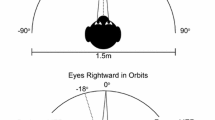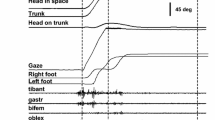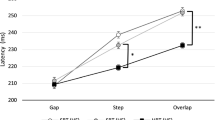Abstract
Human saccades may or may not be associated with head movements. To date, little attention has been devoted to the mechanisms determining head movement recruitment and scaling. Normal human subjects made horizontal, centrifugal saccades along an encircling array of light-emitting diodes. Measurements of gaze, head, and eye-in-head angle were made at the conclusion of the head movement (or at the end of the eye movement in eye-only saccades). We found that head movement amplitude (ΔH) related in a simple fashion to the eye eccentricity that would have resulted if the gaze shift had been performed without a head movement. Plots of ΔH vs this predicted eye eccentricity (E PRED) had a central flat region in which gaze shifts were unaccompanied by head movements (the eye-only range) and two flanking lobes in which ΔH was a linear function of E PRED (the eye-head ranges). ΔH correlated with E PRED better than with gaze shift amplitude, as would be expected if head movements were controlled so as to keep eye eccentricity within a particular range. Head movement tendencies were quantified by the width of the eye-only range, the slope of the eye-head range, and the width of the region within which the eye was likely to be found at the conclusion of the completed gaze-shifting behavior (the customary ocular motor range). The measures ranged widely in these normal subjects: 35.8±31.9° for the eye-only range (mean±SD), 0.77±0.16 for the slope of the eye-head range, and 44.0±23.8° for the customary ocular motor range. Yet for a given subject, the measurements were reproducible across experimental sessions, with the customary ocular motor range being the most consistent measure of the three. The form of the ΔH vs E PRED plots suggests that the neural circuitry underlying eye-head coordination carries out two distinct functions – gating the head movement and scaling the head movement. The reason for the large intersubject variability of head movement tendencies is unknown. It does not parallel intersubject differences in full-scale eye (in orbit) range or full-scale neck range.
Similar content being viewed by others
Author information
Authors and Affiliations
Additional information
Received: 25 June 1998 / Accepted: 23 November 1998
Rights and permissions
About this article
Cite this article
Stahl, J. Amplitude of human head movements associated with horizontal saccades. Exp Brain Res 126, 41–54 (1999). https://doi.org/10.1007/s002210050715
Issue Date:
DOI: https://doi.org/10.1007/s002210050715




